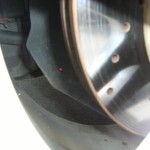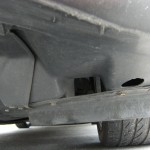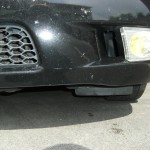A lot of car guys give the OEMs a pretty underwhelming amount of credit. However, I think what they fail to remember is that the original manufacturer, while concerned with many things we typically are not concerned too much with (noise/harshness/cost/etc), spends more money designing the heater knob in your car than most aftermarket part companies make in a decade. Seriously, they're that serious (especially the Japanese and Germans!)
In other words, despite there being some very clever tuners out there, the OEMs are usually FAR more clever (and better funded/resourced) than we give them credit for - and thus, in the right cars, they can be a great source of inspiration.
Older cars and slower cars can always look to newer and faster cars for great ideas. In this article, I'm going to show you how you can look to ingenious OEM designs to improve your own car.
Discovery
While working on Project Lexus, I was thinking about putting together an article on a cheap brake upgrade in the form of brake ducts. We'll probably do something on that in the future, but while doing a bit of research, I noticed that the IS300 actually already has brake ducts - and some rather clever ones at that!
They actually have implemented them in a way that many of you can replicate to reduce drag AND get some really effective brake cooling in the process.
The IS300 has a very low coefficient of drag (0.29 cD) which is extremely low for a sedan. To give you an idea, most Hondas people are familiar with have more like a 0.32 drag coefficient which is actually quite a huge difference despite the seemingly small numerical difference. Achieving less than 0.30 is a bit of a technical challenge so the 0.29 figure is quite impressive. This low drag helps the IS300 achieve reasonably good highway mileage even though the city mileage for the car is pretty in line with a 20 year old inline 6 cylinder design. The low drag also helps the car battle air resistance as speed increases (say at the end of the drag strip, or on a high speed run).
The underpanels on the car are extremely important to creating that low drag coefficent, as are little touches like the way the door mirrors are shaped and distanced from the A-pillar somewhat. Some guys think they can just chuck the wheel well liners and the underpanels of their car and save weight. After all, they reason, they're just there to protect the car from water and such. However, I'm afraid that's quite wrong.
The under panels are all there to reduce the drag of the car, which, in most cars, the underside of the car is one of the most aerodynamically "dirty areas" of the car. This is one reason why you'll hear me constantly saying that many enthusiasts have RUINED their car rather than made it better in their attempts to improve the car. You really do need to think before you do things and be willing to go against the forum nonsense which is VERY often completely wrong.
The Clever Bits
Anyhow, on to the clever bits... The IS300 utilizes little lip spoilers just ahead of the front and rear wheels. This is done on most newer cars because it has been found to reduce the drag caused by the front wheels (which are a huge percent of total drag) significantly. They do reduce ground clearance to a degree, so some people get tired of them scraping and remove them - again, a mistake.
I did notice something quite odd however when I was looking for a place to run brake ducts (inspired by the DC5 Integra and BMW M3). The lip spoiler didn't sit completely flush against the underpinning. Instead, about half way in the middle of it, just above it, there was a large 'duct' or hole really.
Now, the IS300's front brakes have something you see on most cars - dust shields. Many people also think these are just to protect the brakes, and while they DO to some degree do that, they are primarily there to serve as "scoops" to pick up air and direct it into the center of the rotors where the air flows through the vents in the brake discs and out the sides. They also cool the wheel bearings to prolong their life.
On the IS300, they SEEM at first glance to not even barely stick out past the tire. So, at first glance, aftermarket brake ducts still seem like a great idea.
However, that hole above the lip spoiler had me thinking. Either that hole was there because the engineers knew that no air would be flowing there for some reason and thus it wasn't worth the extra plastic to fill the void OR they were using it to pipe air somewhere.
So, I have a IR thermometer that happens to have a very flat face on it, and a laser pointer on the inside. Modeling air flow in any place is often quite difficult and not entirely straight forward, but, if you ever want to have a pretty good idea of where air is going to flow - it's in the straightest path possible. Thus, point a laser pointer from the middle of any duct is a great way to see where it's directing air.
 Therefore, to find out where this duct WOULD be blowing air, I simply butted the face of my IR thermometer up against the lip spoiler and pulled the trigger. Imagine that, the laser regardless of where I moved the thermometer in that hole, pointed directly at the air scoop on the front brakes!
Therefore, to find out where this duct WOULD be blowing air, I simply butted the face of my IR thermometer up against the lip spoiler and pulled the trigger. Imagine that, the laser regardless of where I moved the thermometer in that hole, pointed directly at the air scoop on the front brakes!
Further testing with my differential pressure meter showed that there was a HUGE pressure build up on the front of the spoiler, around 3 inches of water at 70mph which is one of the highest pressure areas on the car I've measured at that speed. On the rear of the spoiler, there was a 0 to even negative 0.1 inches H2O pressure. Air flows from areas of high pressure to low pressure, so I know from this measurement that a great amount of air flow is occurring through that "duct". See, I told you the differential pressure meter is worth every penny and has a million uses. It also reiterates my point that when you want to do modifications - MEASURE first.
I can assure you too that while this duct seems very indirect that it's extremely efficient. It is somewhat unique too as I've seen many OEM brake ducts and usually they're not done this way. You'll see similar designs in many BMWs (though they usually use ducts from the grille area), and in the JDMDC5 Integra Type-R. In fact, for those of you with RSXes, those ducts are an OEM fit and work great from what I'm told. They just don't come with the added benefit of reducing front wheel drag.
The best news is, this EXACT setup can be built on just about any car, old or new, and you can get a huge drag savings AND cooler brakes. It'll also cost you around $10-15 if you do it right. Before I get to how, let's talk quickly about some of the reasons this information is helpful on our project car.
On project Lexus, first of all, we now know there's yet another possible downside to running wider wheels up front. The good news is, most people usually do not. However, on some FWD cars, it's a consideration you might want to check out, especially if your car has OEM brake ducting of some kind. The more negative the offset goes from original, the more likely the wheel/tire is getting in the way of the front brake's cooling. Food for thought.
We also know that while we might be able to run another duct just above this one to get a little more air flow to the brakes, it's probably a low priority modification and not necessarily going to be worth the time as long as that OEM dust shield and brake duct setup is there.
Finally, it makes us wonder if a big brake kit that requires the dust shield to be removed would be worthwhile without significant increases in rotor diameter since you'd gain heat sink area (in rotor size), but you'd also lose the somewhat forced air oem brake cooling system. Nothing definitive to say about this, but something to think about. There are, fortunately, some options that will allow us to keep the dust shield and get more rotor area as well. But more on that another time.
So What?
Well, there's a few things we can learn from this. First of all, if I get nothing through to you, it's imperative that you start to respect the factory design. In most cases, it was done that way for a very specific reason and you better understand that reason very well before you go and mess with it in the name of improvement. In another article, I'll talk about why most air intake modifications people undertake are completely bogus and reinforce this point.
However, the exciting thing about this little 'discovery' (I'm sure I'm not the first to notice it or exploit it), is that it can be replicated EASILY on any car.
All you need is a bit of plastic and some bits from a hardware store and you can create little lip spoilers just like this. You can also cut out a void just above it to direct air to your OEM brakes.
If your car was made prior to say 2000 or so, you probably don't have these little spoilers. If you do, consider using them to your advantage. Here's the measurements for the ones on the IS300 in terms of length and height: 10.25x1.25"
It is somewhat important that you not oversize these lip spoilers as they can also cause drag if too large. It is safe however to assume that the size on the IS300 is probably okay for any car. If you don't feel like making your own, you could probably retrofit some from a factory Honda or Toyota very easily. They simply need a place to bolt to.
You will have to be creative to figure out exactly how to mount yours, but it shouldn't be too dififcult. I'd love to see some people post up pictures of what they come up with.
If you've removed the under panels and wheel well liners, you might also want to put them back on as it's hurting the aerodynamics of your car. Buy new ones if you have to. If you removed the wheel liner to get more air to your cold air intake, you've also probably hurt yourself as this means the air intake will be sucking up air from an area that is usually a low pressure area.
If you cannot fit combination brake vents and lip spoilers, fit the lip spoilers anyway and save yourself some gas and high speed drag. You can always run brake ducts in the same way the DC5 integra runs them. Just find a high pressure area on the front of the car (usually the front grille opening or fog light area is great), and run some cheap ducts to a place in the wheel well that is facing the oem brake dust shields. Use a cheap laser pointer to find the best place to put the exit of the brake ducts. No need (especially on a street car) to run the ducts completely over to the brakes themselves if there is a good enough OEM brake "scoop". There will also be basically 0 risk of over cooling the brakes or having stones get thrown into the middle of the rotor, etc.
Extremely Limited Time Offer - 3 Days Only
Get a MASTERS DEGREE in Performance Tuning from the BEST in the Field for ONE low package price
For 3 days only, get ALL of our PREMIUM (not available anywhere else) Tuner University Courses featuring some of the greatest minds in motorsports:
- Top 10 Performance Myths Class (MP3 and Edited Transcript) - $29.95 value
- Performance on a Sip of Fuel Class (MP3 and class manual) - $69.95 value
- Header Design Secrets with John Grudynski (MP3 and transcript) - $69.95 value
- Dirty Secrets of Oil with Ryan Stark (MP3 and transcript) - $69.95 value
- Engine Tuning Secrets with Ben Strader of EFI University (MP3 and Transcript) - $69.95 value
Get all of the above courses (many of which not currently available anywhere else) for one single price of just $309.75 $69.95. A HUGE package savings.
You can also buy any of these individually through our resource center, but I don't know why you would as this is basically the whole store for the price of just 1 course. You'll get the MP3 recordings of each class as well as a transcript or companion manual with each course and you'll be able to download them all INSTANTLY.







